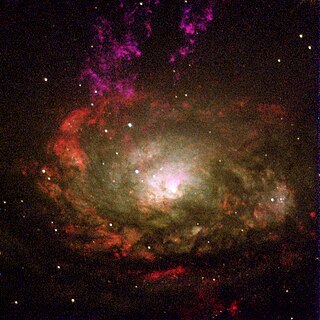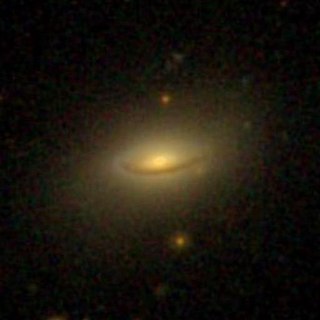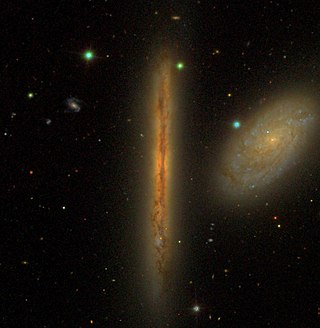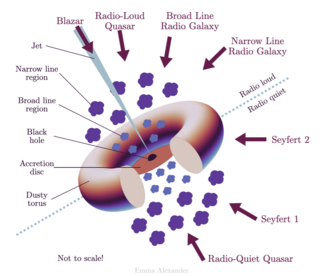An active galactic nucleus (AGN) is a compact region at the center of a galaxy that emits a significant amount of energy across the electromagnetic spectrum, with characteristics indicating that this luminosity is not produced by the stars. Such excess, non-stellar emissions have been observed in the radio, microwave, infrared, optical, ultra-violet, X-ray and gamma ray wavebands. A galaxy hosting an AGN is called an active galaxy. The non-stellar radiation from an AGN is theorized to result from the accretion of matter by a supermassive black hole at the center of its host galaxy.

In the fields of Big Bang theory and cosmology, reionization is the process that caused electrically neutral atoms in the universe to reionize after the lapse of the "dark ages".

NGC 5548 is a Type I Seyfert galaxy with a bright, active nucleus. This activity is caused by matter flowing onto a 65 million solar mass (M☉) supermassive black hole at the core. Morphologically, this is an unbarred lenticular galaxy with tightly-wound spiral arms, while shell and tidal tail features suggest that it has undergone a cosmologically-recent merger or interaction event. NGC 5548 is approximately 245 million light years away and appears in the constellation Boötes. The apparent visual magnitude of NGC 5548 is approximately 13.3 in the V band.

Ionization cones are cones of ionized material extending from active galactic nuclei, predominantly observed in type II Seyfert galaxies. They are detected through their emission of electromagnetic radiation in the visible and infrared parts of the spectrum. The main method of observation is through spectroscopy, using spectral line analysis to measure the shape of the ionized region and the condition of the material such as temperature, density, composition, and degree of ionization.

3C 305, also known as IC 1065, is a lenticular galaxy located in the constellation Draco. The galaxy is located 577 million light-years away from Earth. It has an active galactic nucleus and is classified as a Seyfert 2 galaxy. This galaxy was discovered by American astronomer Lewis Swift on April 7th, 1888.

NGC 4698 is a barred spiral galaxy located around 55 million light years away from Earth in the constellation of Virgo. It belongs to the Virgo Cluster of galaxies and is positioned near the northeastern edge of this assemblage. The morphological classification of NGC 4698 in the De Vaucouleurs system is SA(s)ab, which indicates a purely spiral structure with moderate to tightly wound arms. It is inclined to the line of sight from the Earth by an angle of 53° along a position angle of 170°.

NGC 708 is an elliptical galaxy located 240 million light-years away in the constellation Andromeda and was discovered by astronomer William Herschel on September 21, 1786. It is classified as a cD galaxy and is the brightest member of Abell 262. NGC 708 is a weak FR I radio galaxy and is also classified as a type 2 Seyfert galaxy.

NGC 7130 is a spiral galaxy located in the constellation Piscis Austrinus. It is located at a distance of about 220 million light years from Earth, which, given its apparent dimensions, means that NGC 7130 is about 100,000 light years across. It was discovered by John Herschel on September 25, 1834, and discovered independently by Lewis Swift on September 17, 1897. The location of the galaxy given in the New General Catalogue was off by 30 arcminutes in declination from the location of the galaxy.

NGC 1386 is a spiral galaxy located in the constellation Eridanus. It is located at a distance of circa 53 million light years from Earth, which, given its apparent dimensions, means that NGC 1386 is about 50,000 light years across. It is a Seyfert galaxy, the only one in Fornax Cluster.

NGC 4074 is a peculiar lenticular galaxy located 310 million light-years away in the constellation Coma Berenices. It was discovered by astronomer William Herschel on April 27, 1785 and is a member of the NGC 4065 Group.

NGC 4302 is an edge-on spiral galaxy located about 55 million light-years away in the constellation Coma Berenices. It was discovered by astronomer William Herschel on April 8, 1784 and is a member of the Virgo Cluster.

III Zw 2 is a Seyfert 1 galaxy located in the Pisces constellation. It has a redshift of 0.089 and is notable as the first of its kind to exhibit a superluminal jet.

An extended emission-line region (EELR) is a giant interstellar cloud ionized by the radiation of an active galactic nucleus (AGN) inside a galaxy or photons produced by the shocks associated with the radio jets. An EELR can appear as a resolved cloud in relative nearby galaxies and as narrow emission lines in more distant galaxies.

Markarian 817 is a barred spiral galaxy located in the constellation Draco. It is located 456 million light-years from Earth, which, given its apparent dimensions, means that Markarian 817 is about 80,000 light-years across. It is a Seyfert galaxy.

4C +29.30 is an elliptical galaxy located in Cancer constellation. Its redshift is 0.064840 which corresponds to a light travel time of 850 million light-years from Earth. It is a wide-angled tailed radio galaxy (WAT) and a Seyfert galaxy.

IRAS 09104+4109 is a galaxy located in the constellation Lynx. With a redshift of 0.440797, the light travel time for this galaxy, corresponds to 4.8 billion light-years from Earth. It is the brightest cluster galaxy in MACS J0913.7+4056 galaxy cluster and classified as a hyperluminous infrared galaxy.

PG 0844+349, also known as TON 951, is a galaxy in the southern constellation Lynx, near the border of Cancer. Its redshift is 0.064000, putting the galaxy at 849 million light-years away from Earth.

4C +72.26 known as NAME TX J1908+7220, is a radio galaxy located in the constellation Draco. At the redshift of 3.53, the galaxy is located roughly 11.5 billion light-years from Earth.

IRAS 13349+2438 is a Seyfert galaxy located in the constellation of Boötes. It is located 1.45 billion light-years from Earth and a prototype infrared-luminous low-redshift quasar with a projected luminosity of 2 x1046 erg s-1 according to Beichman who discovered it in 1986.

IRAS 07598+6508 known as IRAS F07599+6508, is a quasar located in the constellation of Camelopardalis. It is located 2.37 billion light years from Earth and is classified as both an ultraluminous infrared galaxy and a Seyfert galaxy.



















